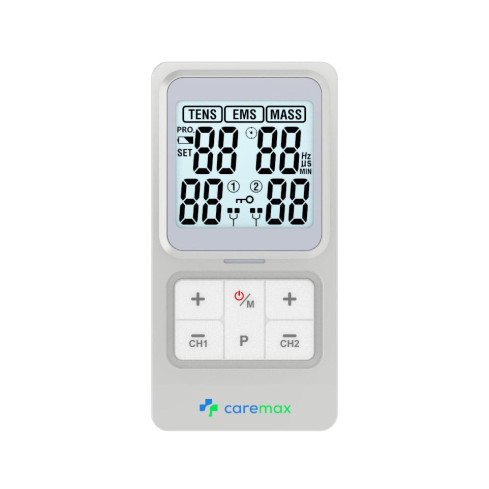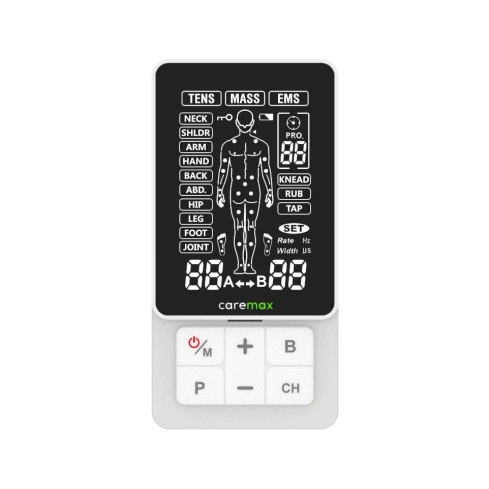Product added to cart
- Home
- TENS & EMS
- Use TENS Machine for Knee Pain, A Complete Guide
Knee pain refers to any unpleasant sensation that occurs around the knee. People with knee pain can describe it as sore, achy, sharp, numb or stabbing. It is one of the most common areas Australians experience in their body. According to a study from the University of Adelaide, around 30-35% of Australians experience knee pain [1].
The knee is a complex part of the body that is made up of muscle, joints, bones, ligaments, cartilage, fat, tendons, nerve endings, and fascia. Knee pain is a sign that one or more of these structures are experiencing inflammation, damage, injury or other changes.
Cause of Knee pain
There is no single cause of knee pain. Reasons for knee pain depend on the type of condition responsible for the knee pain. For instance, an anterior crucial ligament (ACL) tear is typically caused by sports or work-related injuries. In comparison, knee osteoarthritis is usually related to aging.
Examples of knee pain causes include:
- Sports injuries
- Overtraining
- Improper training habits (e.g. unfitting footwear, poor training program, etc.)
- Trauma (e.g. car accidents, collisions, etc.)
- Ageing
- Medical conditions (e.g. sciatica, rheumatoid arthritis, etc.)
Range of Knee Pain Symptoms
There are many symptoms associated with knee pain. Once again, these symptoms depend on the reason behind the knee pain. In some instances, symptoms are temporary, while other symptoms can become chronic.
Examples of symptoms associated with knee pain include:
- Difficulty with weight-bearing activities (e.g. standing for long periods, walking, etc.)
- Weakness
- Swelling
- Inflammation
- Reduced knee mobility and flexibility
- Tight muscles and knots
- Poor performance (e.g., sports, occupational work, etc.)
Type of Knee Pain
Knee pain can be separated into acute and chronic pain.
Acute knee pain is discomfort around the knee that has recently occurred within the last 3 months. It will typically describe conditions that have occurred from a specific incident or rapidly worsened, including:
- Patella dislocation or subluxation
- Cruciate ligament injury (i.e. PCL, ACL rupture, etc.)
- Collateral ligament injury (i.e. LCL or MCL tear)
- Meniscus tear
- Quadriceps or patella tendon rupture
- Fractures
Chronic knee pain refers to discomfort around the knee that has persisted for more than 3 months. It typically describes conditions that have progressively worsened due to prolonged periods of use or due to aging. Conditions associated with knee pain include:
- Knee osteoarthritis
- Patellofemoral syndrome
- Patella or quadriceps tendinitis/tendinopathy
- Chondromalacia
- Bursitis
What is a TENS machine, and how can it help relieve Knee pain?
A TENS machine is known as a transcutaneous electrical nerve stimulator. The primary purpose of a TENS machine is to help relieve the body from pain. It uses gel pads to deliver electricity through the skin and surrounding tissue around the body. These electrical signals can help reduce pain signals or messages that enter the brain [2].
Nerve endings inside and around provide information to the brain about the current state. When the body detects harm (e.g., trauma or injury to the knee), the nerves send 'nociceptive' signals to the brain. If this signal is large enough, the brain will receive these signals in the form of what we feel as 'pain.'
TENS machines send competing signals to the brain to block or reduce the feeling of pain.
What's the best way to use a TENS machine for Knee pain?
There is no single way to use a TENS machine for knee pain, and it will depend on your unique set of circumstances and what you are trying to achieve. However, there are two ways a TENS machine can be used for relieving knee pain.
The first circumstance is using the TENS machine for immediate knee pain relief [2]. When adjusted to a high-frequency setting, the TENS machine should be used to treat present knee pain. An example would be experiencing increasing discomfort in the knee after a run. You can expect immediate pain relief during the treatment when used during high frequency.
A second scenario would be to use the TENS machine for delayed pain relief [2]. When adjusted to a lower frequency, treatment from the TENS machine may not be noticeable until after the treatment. You may expect to feel pain relief over minutes or hours progressively. An example would be proactively using the TENS machine before sleep to help relieve nighttime pain.
These are two common ways experts recommend using the TENS machine effectively for knee pain.
Best practices for using a TENS unit:
While the TENS unit can be used universally, some practices should be used for the most effective way of helping relieve knee pain.
-
Position of electrode pads for Knee pain
The most effective placement of the electrode pads will be around the site of the knee pain. Typically, the area between the positions of the gel electrodes experiences the most relief. One of the most common placements can be seen in the diagram below – either between either side or surrounding the kneecap. Please refer to the guide included with your TENS unit for more guidance about electrode placement. Alternatively, the conductive knee brace would be the ideal option to treat the area that is hard to reach by electrode pads.
-
Setting the TENS Mode for Knee pain
Most TENS units have various settings and modes, which can be beneficial depending on your circumstances. Fortunately, the TENS machines from Caremax provide the convenience of pre-programmed treatments or the flexibility to adjust your settings.
The pre-programmed modes in our TENS machines allow you to simply plug in and start your treatment. Most TENS machines have guides that inform you which program might be more suitable for the type of pain you would like to treat.
However, some TENS machines also allow you to customise your treatment by adjusting the settings. There are three main settings to help tailor your pain relief, including intensity (milliamps or Ma), frequency (Hz) and pulse width (μs). Adjusting each setting can help you receive the most effective treatment for yourself.
- Frequency determines how many electrical pulses are being delivered through the gel electrodes. This setting can be changed depending on whether you need immediate or delayed pain relief
- Pulse width measures the duration of each electrical pulse. Changing the pulse width adjusts the stimulation and comfort someone receives during treatment [3]. However, is uncertainty about whether it influences pain relief [4].
- Intensity can be adjusted to measure the strength of the treatment. This setting is essential for ensuring you're receiving an effective treatment without too much discomfort.
-
Setting the Pulse Rate (Frequency) for Knee pain
Pre-programmed settings will have a constant pulse rate or frequency. Switch to the adjustable settings to change the frequency for your needs. Typically, a frequency between 80-120Hz is used to manage acute knee pain by providing immediate relief during treatment. Low frequencies between 2-5Hz are more commonly used for chronic knee pain where the treatment is long-lasting and helps relieve pain even after the TENS machine is stopped [2].
-
Setting the Pulse Width for Knee pain
Pulse width can be set anywhere between 1-400μs depending on the range of the TENS machine and your preferences. The higher the pulse width, the greater stimulation you will experience during the treatment. No evidence suggests that the pulse width setting alone will significantly influence the amount of relief from knee pain [4].
-
How Often Should You Use Your TENS Machine for Knee pain?
How often your TENS machine should be used for knee pain will depend on your unique circumstances. Talking to a health professional, such as a doctor or physiotherapist, with knowledge about electrotherapeutic medical devices is important.
Researchers have noted that 15-30 minutes of continuous TENS machine use can assist with knee pain [2]. There seem to be no issues associated with multiple uses throughout the day unless you have specific medical conditions (mentioned below) or find tolerating the treatment difficult. Those with sensitive skin may find the treatment too harsh when exposed to long treatment durations or frequent use.
Signs that may indicate that the TENS machine is being used too frequently are skin reddening and continuous discomfort around the application area.
Additionally, some research has shown that consecutive use over five days may lead to increased tolerance [5]. As a result, you may feel the treatment becomes less effective (in the same settings) with consistent use. Try to avoid relying on the TENS machine for continuous use unless necessary. Attempt to space the time between each TENS treatment to prevent tolerance.
Using Caremax TENS machine for Knee Pain Mangement
We provide a comprehensive packaging solution for Knee Pain Relief. Discover the most sought-after products below essential for effective TENS therapy treatment.
 |
 |
| Caremax 2.0 Classic TENS machine | Caremax 2.0 Pro TENS Machine |
Where and when to not use TENS machines
TENS machines are a generally safe treatment for knee pain. However, there are circumstances where you may consider avoiding it. Always speak to a healthcare professional if you have any concerns or the following conditions/circumstances [6]:
- Have an electrical implant in the body (e.g. pacemaker, neurostimulators, etc.)
- Over open wounds or cuts
- Around sensitive, inflamed, irritated or swelling areas over the skin
- During pregnancy (speak to your doctor about appropriate use)
- Areas that are at risk of clotting
- Over sites of infection
- If someone cannot consent to treatment (e.g. those with cognitive impairments)
- Over areas that lack sensation or feeling
Are there any risks of side effects when using a TENS Machine?
One of the main benefits of using a TENS machine is the limited and uncommon side effects [7] compared to other pain relief treatments, such as medications and injections. People have reported minor side effects when using the TENS machine, including skin reactions to the gel pads, altered sensation after treatment, and worsening pain. You must speak to your doctor before using a TENS machine if you have any of the conditions above.
References
- Blacketer, C., Gill, T., Taylor, A., & Hill, C. (2019). Prevalence and healthcare usage of knee pain in South Australia: a population‐based study. Internal medicine journal, 49(9), 1105-1110.
- https://web.archive.org/web/20170809062344id_/https://www.wwmsi.com/documents/WWMSI_Transcutaneous_Electrical_Nerve_Stimulation_Tim_Watson.pdf
- https://elsevier.health/en-US/preview/transcutaneous-electrical-nerve-stimulation-unit-pain-treatment
- Chen, C. C., Tabasam, G., & Johnson, M. I. (2008). Does the pulse frequency of transcutaneous electrical nerve stimulation (TENS) influence hypoalgesia?: A systematic review of studies using experimental pain and healthy human participants. Physiotherapy, 94(1), 11-20.F
- Liebano, R. E., Rakel, B., Vance, C. G., Walsh, D. M., & Sluka, K. A. (2011). An investigation of the development of analgesic tolerance to TENS in humans. PAIN®, 152(2), 335-342.
- https://www.healthcare.uiowa.edu/marcom/uihc/pain_medicine/contraindication_precautions_best062018.pdf
- Simpson, P. M., Fouche, P. F., Thomas, R. E., & Bendall, J. C. (2014). Transcutaneous electrical nerve stimulation for relieving acute pain in the prehospital setting: a systematic review and meta-analysis of randomized-controlled trials. European Journal of Emergency Medicine, 21(1), 10-17.
Categories
- TENS & EMS (20)
- Latest News (41)
- Massager (2)
- Nebuliser (8)
- Skin Care (3)
- Period Pain Management (1)
- Fitness (2)

